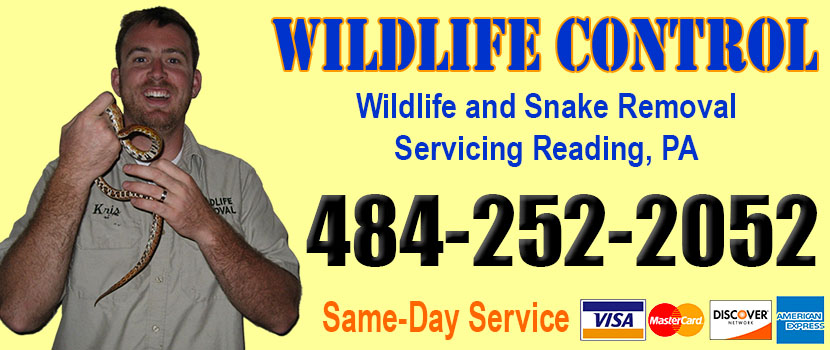
Welcome to readingsnakes.com! I am David, a snake enthusiast living in Reading, PA. Many people don't know that Reading is in fact full of snakes! You just need to know where to find them - they can often be shy and elusive. Some Pennsylvania snake species are more common outside of the city limits, in different parts of Berks County PA, but many types of snakes are indeed common in the more urban parts of Reading. This guide is meant to help educate you about the beautiful snakes of Reading, and to help you identify the most common snakes of Reading, as well as the venomous snakes of Reading that you should learn to recognize and avoid. If you want more detail, click here for my complete list of ALL snake species in Reading. Remember the following:
- Most snakes of Reading are harmless and don't want to encounter you
- Venomous snakes exist but are uncommon in Reading, Pennsylvania
- Snakes eat rats and mice and are a valuable part of the Pennsylvania ecosystem
- Never kill a snake - if you leave a snake alone, it will leave you alone.
Common Snake Species in Reading
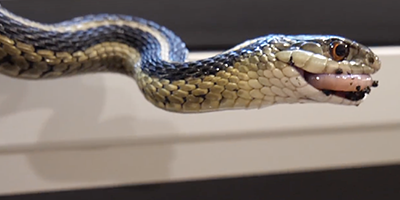 Eastern Garter Snake:
The eastern garter snake (Thamnophis sirtalis) is a widespread species found throughout North America. They like moist, grassy environments but can be found away from water. They can be found in populated areas where there is cover (debris, boards, logs, vegetation). They are not venomous.
Eastern Garter Snake:
The eastern garter snake (Thamnophis sirtalis) is a widespread species found throughout North America. They like moist, grassy environments but can be found away from water. They can be found in populated areas where there is cover (debris, boards, logs, vegetation). They are not venomous. Adult eastern garter snakes are typically 20-28 inches in length. They usually have three yellow longitudinal stripes down a dark body. A few have a checkered pattern with light stripes or reddish body color. They are active both day and night and throughout the year. They are common and not a protected species.
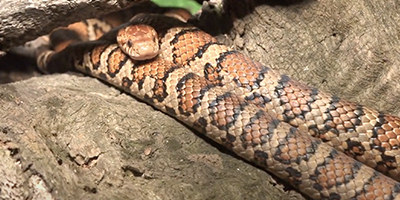 Eastern Milk Snake:
The eastern milk snake (Lampropeltis trangulum) is a nearly universal species that can be found from Canada, throughout much of the United States, and into Mexico and Ecuador. They are typically found in fields, woodlands, and rocky hillsides but like dark places where they can take cover, such as trash piles and basements. They are not venomous and even are kept as pets.
Eastern milk snakes have a distinctive pattern of light to reddish-brown bands that are bordered by a thin black line on a gray to light brown to red background. They are often mistaken for the more dangerous copperhead snake. Adult eastern milk snakes average 24 to 52 inches in length. They are primarily nocturnal.
Eastern Milk Snake:
The eastern milk snake (Lampropeltis trangulum) is a nearly universal species that can be found from Canada, throughout much of the United States, and into Mexico and Ecuador. They are typically found in fields, woodlands, and rocky hillsides but like dark places where they can take cover, such as trash piles and basements. They are not venomous and even are kept as pets.
Eastern milk snakes have a distinctive pattern of light to reddish-brown bands that are bordered by a thin black line on a gray to light brown to red background. They are often mistaken for the more dangerous copperhead snake. Adult eastern milk snakes average 24 to 52 inches in length. They are primarily nocturnal.
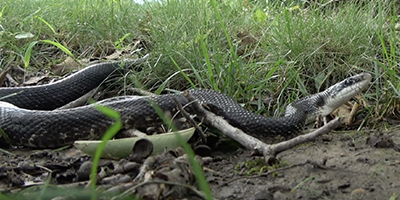 Eastern Rat Snake:
The eastern rat snake (Pantherophis alleghaniesnsis) is endemic to the eastern-southeastern United States. They are typically found in meadows and open wooded areas but are attracted to areas with cover and any place with rodents to hunt. They are not venomous but do emit a foul musk when threatened that smells like and has the taste of poison.
Eastern rat snakes are the largest snake common to Pennsylvania. The adults average between 3 and a half feet and 7 feet long. The black scales on their back are shiny and they have light-colored bellies, with white scales at the throat and chin. The head is wider than the rest of the body. They brumate in cold months. Brumation is similar to hibernation but the snake occasionally awakens for activities like drinking water.
Eastern Rat Snake:
The eastern rat snake (Pantherophis alleghaniesnsis) is endemic to the eastern-southeastern United States. They are typically found in meadows and open wooded areas but are attracted to areas with cover and any place with rodents to hunt. They are not venomous but do emit a foul musk when threatened that smells like and has the taste of poison.
Eastern rat snakes are the largest snake common to Pennsylvania. The adults average between 3 and a half feet and 7 feet long. The black scales on their back are shiny and they have light-colored bellies, with white scales at the throat and chin. The head is wider than the rest of the body. They brumate in cold months. Brumation is similar to hibernation but the snake occasionally awakens for activities like drinking water.
Venomous Snake Species in Reading
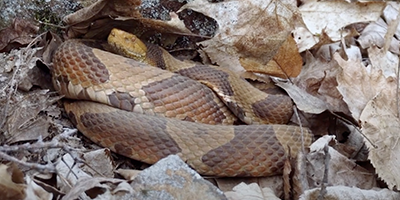 Northern Copperhead Snake:
The northern copperhead snake (Agkistrodon contortrix mokasen) is found in the United States from the Florida panhandle to as far north as Massachusetts and as far west as Nebraska. They are comfortable in both aquatic and terrestrial habitats and they like abandoned areas, rotting woodpiles, and construction sites. They are venomous and even newborns have fangs that are capable of injecting venom into a prey’s bloodstream. They are aggressive in self-defense.
Northern copperheads have camouflage of light tan to gray-brown with wide darker brown to red-brown bands which are narrow across its sides and narrow on its back. They have a distinctive triangular head that is flat. In the summer they are primarily nocturnal and they hibernate in the winter.
Northern Copperhead Snake:
The northern copperhead snake (Agkistrodon contortrix mokasen) is found in the United States from the Florida panhandle to as far north as Massachusetts and as far west as Nebraska. They are comfortable in both aquatic and terrestrial habitats and they like abandoned areas, rotting woodpiles, and construction sites. They are venomous and even newborns have fangs that are capable of injecting venom into a prey’s bloodstream. They are aggressive in self-defense.
Northern copperheads have camouflage of light tan to gray-brown with wide darker brown to red-brown bands which are narrow across its sides and narrow on its back. They have a distinctive triangular head that is flat. In the summer they are primarily nocturnal and they hibernate in the winter.
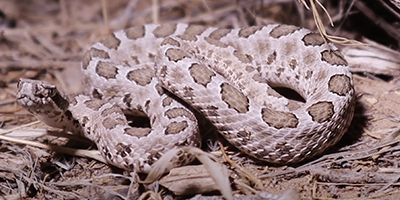 Eastern Massasauga Rattlesnake:
The eastern massasauga rattlesnake (Sistrurus catenatus) is found in large parts of the eastern and Midwestern United States, and as far north as Ontario, Canada, and as far south as Mexico. They like wetlands and are secretive creatures, seeking out places to hide. They are naturally attracted to places like debris piles and rotted wood. They seek out prey like rodents. Their venom is more toxic than other rattlesnakes but they inject a smaller amount of it than other rattlesnakes. They are shy and rarely bite people.
The eastern massasauga rattlesnake is a thick-bodied, stocky snake with nine enlarged scales on its head. They are usually brownish gray with a geometric pattern of darker patches. They are active during the day and, during the summer, also during the evening. It is federally listed as threatened and, in Pennsylvania, as endangered.
Eastern Massasauga Rattlesnake:
The eastern massasauga rattlesnake (Sistrurus catenatus) is found in large parts of the eastern and Midwestern United States, and as far north as Ontario, Canada, and as far south as Mexico. They like wetlands and are secretive creatures, seeking out places to hide. They are naturally attracted to places like debris piles and rotted wood. They seek out prey like rodents. Their venom is more toxic than other rattlesnakes but they inject a smaller amount of it than other rattlesnakes. They are shy and rarely bite people.
The eastern massasauga rattlesnake is a thick-bodied, stocky snake with nine enlarged scales on its head. They are usually brownish gray with a geometric pattern of darker patches. They are active during the day and, during the summer, also during the evening. It is federally listed as threatened and, in Pennsylvania, as endangered.
If you're unsure, you can email me a photo of the snake at info@readingsnakes.com and I will email you back with the snake's species. If you found a snake skin, read my Found a Skin? page, and you can email me a photo of the skin, and I'll identify the snake for you. If you need professional Reading snake removal help, click my Get Help page, or see the below website sponsor I found, who provides that service.
Do snakes come out in the rain?
Snakes do come out after a period of rain, but this isn't always down to the rain itself, despite being cool and wet. For the most part, it will be down to what the rain attracts that grabs the reptiles interest.
Lots of things come out to play after a good rainy spell. Raccoons will dig up grassy areas to get to insects hiding below the surface of the soil. Toads, frogs, newts, and a wide range of other creatures will come out to enjoy the increased count after a good rainfall, and those insects will also attract birds to the party.
All of those creatures that make use of the time after rain also provide the snake with plenty of food. In many cases, the smaller animals that are attracted by the insects also act as prey for the snake. Larger snakes will obviously hunt down larger prey, but even the biggest snake won't down a small snack from time to time if it just sat there, waiting to be consumed.
There seems to be an increase of pets being attacked by snakes right in their own back garden, especially in areas of the United States where snakes are prolific. It makes sense too, especially if you have a pond or other natural waterway close to your home or property. Toads, frogs, birds, etc. will come out to feast on the increased amount of insects that can be found, and this will draw the snakes in, alongside a host of other predators. It's the natural way of the world — the food chain.
Of course, this does pose a problem for property owners, particularly those with pets and small children. If you live in an area where snake sightings are quite common, it is well worth scouting the back or front yard before you let pets or children go out to play there. If there is a snake hanging around (attracted by what the rain attracts), it won't think twice of snapping when your domesticated cat or dog starts sniffing around, and the snake doesn't need to be venomous in order to be dangerous. Snake and pet conflicts often result in rather nasty wounds, and some of these will require costly vet care.
Many creatures are drawn in by the rain or, rather, that little time after the rain when everything is damp. A lot of creatures, ranging from small insects to larger reptiles, will peer out from wherever they’re hiding. Just remember to watch your step!
Remember, the term is not poisonous snakes of Reading, it's venomous snakes of Reading. Poison is generally something you eat, and venom is injected into you. That said, dangerous snakes are very rare in Reading. The few venomous snakes of Berks County are rarely seen. But they are commonly misidentified, so learn about all the snake species of Reading in order to correctly identify them. These snakes are usually also found in the surrounding towns of Reading,Wyomissing, Boyertown, Kutztown, Hamburg, Sinking Spring, Birdsboro, Leesport, Oley, Fleetwood, Douglassville, Mohnton, Shillington, Blandon, Bernville, Morgantown, West Reading, Wernersville, Robesonia, West Lawn, Womelsdorf, Mount Penn, Temple, Topton, Shoemakersville, Laureldale, Lenhartsville, Kenhorst, Bechtelsville, Bethel, Mertztown, Bally, Shartlesville, Kempton, Strausstown, Mohrsville, Saint Lawrence, Lyons, Virginville, Stouchsburg, Centerport, Rehrersburg, Amity Gardens, New Morgan, Reiffton, Jacksonwald, Gouglersville, Pennside, Stony Creek Mills, Alsace Manor, New Jerusalem, and the surrounding areas.
Read our article about:
How do snakes move?
readingsnakes.com domain and hosting costs made possible by the generous support of this sponsor:
